Home to ancient ruins, temples, roads & statues is one of Turkey’s top attractions, Ephesus. A UNESCO World Heritage Site that delighted me and my family this year. Here is what to see and do in Ephesus – and what not to miss at the Ephesus archaeological site.
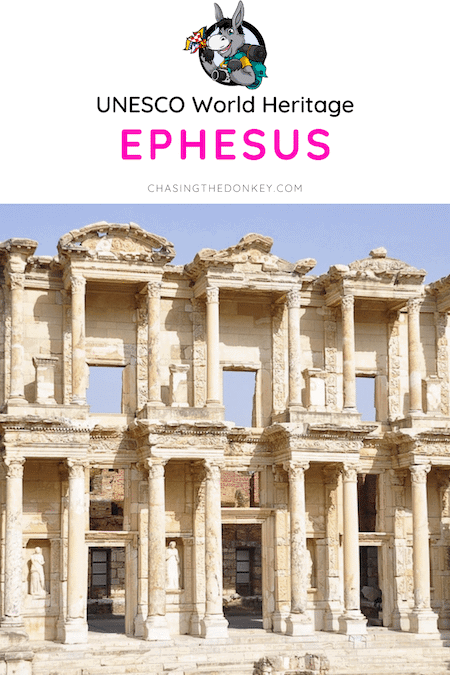
Is the archaeological site of Ephesus worth visiting? A resounding YES! My family and I are big fans. My two little boys (aged 5 & 10) had a blast visiting this ancient site as a part of our Turkish road trip – we roamed free in the winter of 2023 and had a blast and had the ruins almost all to ourselves.
Few places in the world feel as immersive as Ephesus Türkiye. In 2015, ancient Ephesus was added to the UNESCO World Heritage List – an impressive list to be on!
As lovely as visiting a museum or even walking through a regular open-air museum might be, not many of them allow you to immerse yourself entirely in history. When you visit Ephesus, you get just this and more.
At this ancient site, you might feel like ghosts from the past are watching you or that the wind, which occasionally and very randomly whips up out of nowhere, really is the past, reminding you that this place is still very important, even today.

Located near Izmir, just outside of the town of Selcuk, Ephesus used to be an ancient port city. You might hear the word ‘ancient’ and assume it’s in bad condition, but upon walking into the excavation zone, I challenge you not to let your jaw drop.
The vast theater is easy to walk around and explore. You can look down at the central “stage” and imagine gladiator fights happening right before you.
This remarkably preserved site is still being discovered and unearthed, showing you a full-scale city that once was the most important in the Greek Empire. Throughout the entire Mediterranean area, Ephesus was the epicenter of everything, and even though many tried to conquer it, the city remained standing.
These days, Ephesus is not only an essential open-air museum, but it’s also a pilgrimage destination for Christians. Ephesus is mentioned several times in the Bible, and additionally, it’s also the last resting place of St. John.
Here are excellent guided tours that you can join to explore the ancient city better and get up close to the original pieces!
The most popular tours in Ephesus:
- Discover all the highlights of Ephesus with a well-educated professional local tour guide on this tour
- Combine visits to some of Turkey’s most important highlights in this 8-hour guided shore excursion from Kusadasi
- This full-day tour from Izmir takes in all the highlights of the archeological site and includes a delicious Turkish lunch and wine tasting in Sirince village
- Walk along the streets in Ephesus and then visit a village around Ephesus to take a cooking class with locals
- Travel back in time to explore the remarkable Ephesus ancient city on this Bike Tour
Skip Ahead To My Advice Here!
Where Is Ephesus Türkiye On A Map
The History Of Ephesus

Before you visit Ephesus, it pays to read up on the history so you can truly appreciate what you see. You’ll find signposts everywhere and informational stands where you can find out more, but having some knowledge beforehand will take your visit to the next level.
Although Ephesus is in modern-day Turkey, it was originally an ancient Greek city of enormous importance. The city was founded in the 10th century B.C., and later, the Roman Empire took control of it in 129 BC.
This is when Ephesus’ time really came to fruition as the city grew, becoming a bustling and massive place with strategic importance close to the Aegean Sea. At its peak, it is thought that around 50,000 people lived in Ephesus.

Much of the architecture you’ll see today was built during Roman rule, including the famous Temple of Artemis and the vast Ephesos theater, which is in perfect shape, considering its age! In its heyday, the amphitheater could hold around 25,000 people, and many gladiator battles took place there and drama shows. The Temple of Hadrian and the Library of Celsus were also prominent buildings constructed by the Romans.
The city moved into Ottoman Rule between 1304 and 1425, and the city slowly declined during this time.
The history of Ephesus is rich and diverse, and there is a lot of religious significance, too. Many important figures in religious history are said to have visited Ephesus, and the House of the Virgin Mary – Mother of Jesus – is said to be where the Virgin Mary spent her last days.
What To See At The Ephesus Archaeological Site

You’ll see old temples, libraries, statues, houses, and the vast amphitheater.
The Library of Celsus is probably the most iconic picture of Ephesus you’ll see when you Google it. It would be best to spend a good portion of time at this place, looking closely at the intricate decorations, the Roman and Greek inscriptions on the walls, and the sculptures. Words really do not do this place justice.
The Hadrian temple is another highlight, as is the Temple of Artemis, which draws enormous crowds.
Additionally, there’s also a less “serious” side to Ephesus. For example, you can see the old toilets, which are undoubtedly eye-opening given that they’re in public view and a brothel that dates back to the 4th century B.C.
Now protected and preserved as a UNESCO World Heritage Site, Ephesus served as a prominent and prosperous city in the Greek, Roman, and Byzantine Eras before falling into disrepair under Ottoman rule.
This is undoubtedly a city that has many stories to tell. We’ve already mentioned that it’s an important site in Christianity, and that is not only because of the Basilica of St. John. The House of the Virgin Mary is also situated in Ephesus, although you will need to pay an extra supplement on top of the regular entry price if you want to visit.
It’s said that the Virgin Mary lived in this small stone house until she died aged 101. She was taken here by St. John himself.
Top 11 Sights When Visiting Ephesus
What To See In Ephesus If You Only Have One Day

There are more than these, but we recommend these top ones if you are short on time.
- Various Baths of Ephesus
- Ephesus Great Theater
- Library of Celsus
- Prytaneion
- Temple of Hadrian
- Temple of Artemis
- Terraced Houses
- Hercules Gate
- Winged Nike
- Odeon
- Ephesus Museum
1. Varius Bath Of Ephesus

The magnificent marble Baths of Varius are located north of the State Agora and east of the Basilica. The bath was initially constructed in the Hellenistic period, roughly in the second century A.D., and has since undergone numerous restorations. Those renovations are the reason for the building’s distinctive appearance today.
Legendary sophist Flavius Damianus constructed the bath. Damianus and his wife had a private room built for them. Later, a room was also added to the Varius Baths by Vedia Faedrina and Ephesus Vedius Antonius, a wealthy citizen’s daughter. Romans cared about personal hygiene, so they used this bath regularly. It was considered a symbol of prestige.

Over the 2nd century, a few more rooms were added to the baths. As time passed, more and more rooms were being added, one after another. During the 4th century, Scholastica, a wealthy Christian woman, provided the money for the restorations.
The structure received significant renovations in the 5th century to depict the Byzantine Era and its influence on interior decoration. The 40-meter passageway decorated in mosaics is the most evident indication of these alterations. The caldarium (hot portion), tepidarium (warm section), and frigidarium are all features of the bath’s ultimate classical Roman design (cold section).
Today, baths are not in great shape. Some parts of the baths are collapsed, and it is hard to visualize how it looked hundreds of years ago. The baths’ excavations have not yet been finished, so there might be new rooms and chambers in the future. In order to understand what you see beyond the vault area of the building, you may need some background knowledge of Roman bathhouses
2. Ephesus Great Theatre
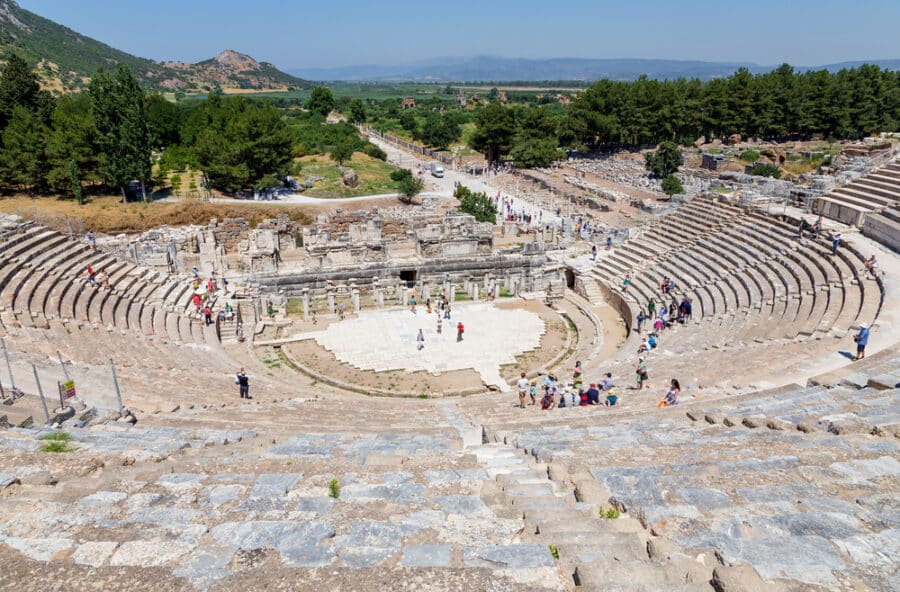
Although there is no archaeological evidence for the Great Theatre’s existence before 100 BC, it is thought to have been constructed during the Hellenistic eras. It was assigned to Lysimachus, the marshal of Alexander the Great. It was Lysimachus who chose this location for the theatre.
Preparing the mountainside for the building’s construction and potential extension took almost 60 years of digging. By the 8th century A.D., the theater had joined the city’s defense system after earthquakes severely damaged it in the 4th century A.D. After those earthquakes, the Great Theatre was never fully renovated.
The theater has a 145-meter diameter and rises 30 meters in height. The capacity of the theatre is 25,000 spectators. It was designed with the stage facing the audience and the harbor in the background.
The theater initially had just one floor. The Roman emperor Neron constructed the stage’s first two stories, and a third floor was later built in the 2nd century. The size of the theatre stage is 25 by 40 meters. The stage is decorated with pillars and sculptures of the gods, goddesses, and emperors. The podium entrance and a secret passageway to an underground tunnel leading to the orchestra pit were both on the ground floor. On all other floors, there are eight rooms and a hallway.
On feast days, offerings would have been made at the altar that was in the center of the stage. The audience in the Roman period paid an admission fee to be entertained, although performances typically began early in the day and continued until late at night.
Gladiator battles would have also taken place in the theater during this period. The theater frequently appears on lists of regional holy places due to its biblical relevance. It is the location where the apostle Saint Paul began anti-pagan preaching. The interesting fact is that the theatre is still being used for concerts. Elton John had one just a few years ago.
3. Library Of Celsus

Of everything to do in Ephesus, Turkey, the Celsus Library, one of Ephesus’ most impressive structures, was the third-largest library in the ancient world.
As a tribute to his father, Julius Celsus Polemeanus, Council Gaius Julius Aquila constructed it in the 1st century A.D. Before his passing, Celsus, a councilman and governor, left money to finish and maintain the enormous library.
A special compartment below the ground level that could be reached via a passageway leading to a gate hidden behind the library’s north wall contained the governor’s marble tomb. So, the library was a heron (shrine) as well.
The Library had two stories and a door off Curetes Street that led inside. The four twin pillars that supported the building are reached after nine stone stairs. Large windows provide enough light for reading within the library. The building was constructed explicitly with an additional set of walls surrounding it to maintain a constant temperature and humidity.
The library was destroyed in the 3rd century A.D. and rebuilt in the fourth. In the first millennium A.D., an earthquake completely destroyed it. An earthquake in the 10th century A.D. once again destroyed it
4. Prytaneion
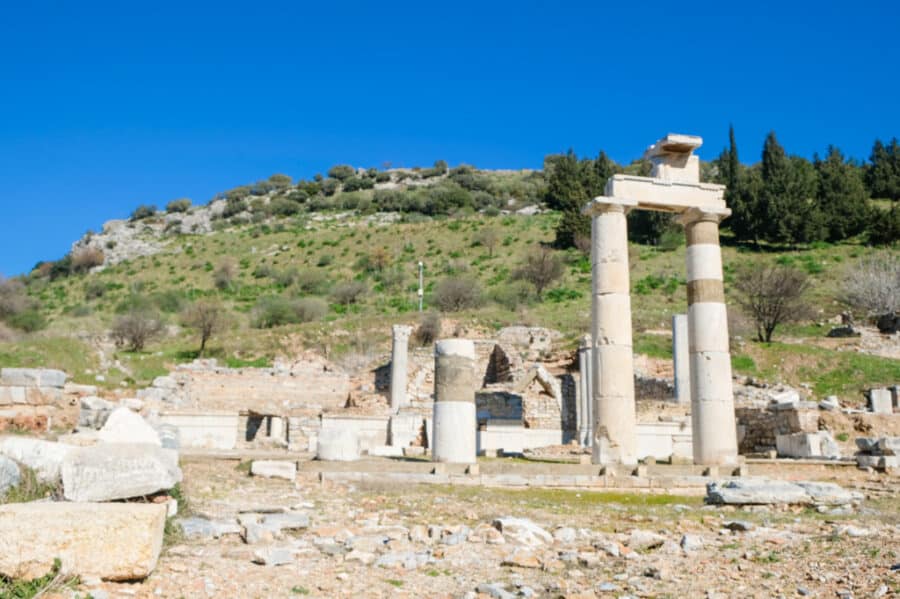
The Prytaneion is located directly behind the market basilica. The building was constructed in the 3rd century B.C. under Lysimachos’ administration. The structure was destroyed during the Augustan era, and some of the Prytaneion’s columns and other elements were utilized in constructing the Scholastica Baths in the fourth century.
Prytaneion served as the city hall or the official administrative structure. Here were held official gatherings, religious rituals, and feasts. The sacred flame, which would have been kept in a four-cornered pit, set a prytaneion construction apart from a bouleterion.
The Curetes, Hestia’s priestesses, would have maintained this sacred hearth burning in honor of Hestia, the goddess of hearth and fire.
Architecturally speaking, the Prytaneion would have been built similarly to a private home. It contained a dining room to host guests from abroad, administrative offices, the state archives, and a conference hall. Only two of the eight columns that once stood in front of the structure may be visible now. These columns lead to an enclosed garden. The garden floor was covered with an Amazonian shield-themed mosaic.
Archaeologists discovered two statues of the goddess Artemis during excavations of Prytaneion. One of these was neatly buried in the shrine, while the larger one was found in the ceremonial hall. These statues are now in the Ephesus Museum.
5. Temple of Hadrian

I totally loved my time at Ephesus with no one there. On Curetes Street, this temple honoring Emperor Hadrian is considered one of the most stunning and well-preserved buildings.
To commemorate Hadrian’s visit to the city from Athens, P. Quintilius built it during the start of the second century A.D. Emperor Hadrian was viewed as one of the Five Good Emperors. Those five (considered) good emperors are Nerva, Trajan, Hadrian, Antoninus Pius, and Marcus Aurelius. These men successfully gained the senate’s support and cooperation, something other emperors had failed to do.
But the name “Temple of Hadrian” is a little misleading. It is not really a temple but actually a monument. And that monument was also dedicated to the goddess Artemis and the people of Ephesus.
The central area of the temple is called Nao. This would have been a tiny space with a big entrance door constructed of small stones. This door’s beams were elegantly ornamented with representations of eggs and pearls.
Recent renovations have been made to the Hadrian’s Temple. Replicas of the ancient statues have been installed in their places. The originals have been taken out and are now on view in the museum in Ephesus.
6. Temple of Artemis
The Temple of Artemis, often called the Temple of Diana, is one of the Seven Wonders of the Ancient World and the first temple made of marble. The Temple was created in the sixth century B.C. Croesus, the wealthy king of Lydia, paid for the early building. One hundred twenty-seven marble columns made up the temple.
In the act of arson on July 21, 356 BC, Herostratus destroyed the Artemis temple in Ephesus. His goal, according to the narrative, was fame at any cost. That same day, Alexander the Great was born. Artemis was reportedly preoccupied with delivering Alexander when her temple caught fire.
Alexander offered to pay for Temple’s reconstruction, but Ephesians rejected Alexander’s offer. The temple was eventually repaired following Alexander’s passing in 323 BC. The Ephesian people reconstructed the temple after the original was destroyed in a Goth assault in 262. The temple was finally demolished in 401. The bulk of Ephesians converted to Christianity during the course of the following two centuries.
Today, the Turkish government is currently considering renovating the Temple of Artemis. The temple is not surrounded by any barriers. All that is visible to visitors is a column that Austrian archaeologists rebuilt. It is a significant spiritual location. Three religions would meet in the same block: an ancient pagan temple, a basilica dedicated to St. John, and a mosque.
7. Terraced Houses

On the northern slope of Bülbülda Hill, close to Curetes Street and across from the Temple of Hadrian, is the magnificent residential complex known as Terrace Houses in Ephesus.
Two housing complexes have already been dug up: Eastern and Western. Beginning in 1960, excavation work on the Terrace Houses began. The houses are still being restored, so there is always something fresh to marvel at there.
The villas are still being restored at this time. Visitors can now observe the meticulous labor of archaeologists thanks to this fact. A substantial roof covers the entire area, shielding the interiors’ priceless contents from the weather’s damaging effects.
Private homes built on three terraces make up the Eastern Complex, which has an area of around 2500 square meters. Domus, a villa occupied by wealthier people and several houses belonging to middle-class people, is the most notable structure.
The complex’s construction began in the first century A.D., and people lived there until the seventh. Naturally, they underwent substantial repairs and renovations in the meantime. There was running water in each home, and each had its own entrance from the street.
At least five luxurious houses with inner gardens made up the Western Complex, which has been flawlessly preserved to the present day. Frescoes and other artwork uncovered during an archaeological investigation are still used to decorate many of the rooms. All the homes in this neighborhood had running water, and the remains of bathtub-equipped bathrooms have been discovered.
Visitor Tip: To see Ephesus’ Terrace Houses, you must pay a fee of 2€. The complex is open every day from 8 a.m…. to 6:30 p.m. from April through October and from 8 a.m. to 4:30 p.m. from November through March.
8. Hercules Gate

The monumental Hercules Gate is believed to have been built in the 5th century on the street close to the Memmius Monument. In Ephesus, only two of the gate’s lintels have been remounted since it collapsed in an earthquake. This gate was named after two reliefs that depicted Hercules draped in lion skins. It was constructed with two tiers of columns. On the second story, it is thought that a plaque of Goddess Nike with a wreath in her hand was mounted at the top.
Locals told us that if you can stand at the gate and touch both sides, you’ll absorb some power from Hercules
9. Winged Nike

On Domitian Square, located on the western side of Kuretes Street, stands a marble relief of the Greek goddess Nike. Dating back to the 1st – 2nd century A.D., it decorated one of the spandrels of Hercules Gate.
Believed to have been mirrored by a similar relief on the opposite spandrel, it is thought to have been moved from another monument in the 4th century A.D. The goddess holds a laurel wreath for victory in her left hand and a palm branch in her right.
I had seen photos on I.G. of this before going. I assumed you could get up close and touch it – as I had seen photos of people’s heads popping up in the space under Nike or sitting on the edge – but the area is dropped off, and my guide told me that people continue to touch the marble which is not good.
While visitors may delight in seeing this sculpture, it may one day be moved to the Ephesus Archaeological Museum with other vital artifacts found on site to keep it safe – so please do not touch her
10. Odeon
The Odeon in Ephuses is one of the most interesting and well-preserved Roman ruins in the world. The Odeon was built in the 2nd century A.D. and could seat up to 1,500 people.
It was used for music concerts and poetry readings. The Odeon has a unique design with a half-circle of seats on one side and a stage on the other. The stage is still in remarkably good condition, and you can imagine what it would have been like to see a performance here centuries ago.
11. Ephesus Museum
The ideal addition to a tour of the Ephesus ruins is a trip to the Ephesus Archaeological Museum in Selçuk. There are several artifacts from the ancient city, the Temple of Artemis, the Basilica of St. John, and the fortress on the Ayasuluk Hill in the collections of this modest but intriguing museum.
Other neighboring archaeological sites are also featured, including the Belevi Mausoleum and the ukuriçi Mound, where the oldest object in the museum’s collection—a stamp from 6200 BCE—was discovered.
The museum’s collection includes artifacts from many historic and prehistoric eras, such as the Mycenaean, Classical, Roman, Geometric, Archaic, Hellenistic, Byzantine, and Ottoman periods.
The archaeological section’s eight main rooms are divided into sections on the cult of Kybele, the finds from the Artemision, the terrace houses of Ephesus, ancient coins, the presentation of Ephesus through the ages, and stone artifacts in the garden. The museum’s garden and designated exhibition spaces are areas where the exhibits are displayed geographically rather than chronologically.
Museum Visitor Info
The Ephesus Archaeological Museum in Selçuk is open daily from 8:00 a.m. to 6:30 p.m. in the summer (April through October) and from 8:30 a.m. to 5:30 p.m. in the winter (November through March). The cost of the ticket is around 1€. The ticket office closes 30 minutes earlier.
There is a small cafeteria and a gift shop at the museum. Near the entrance, there are restrooms as well.
The Ephesus Archaeological Museum is located in Selçuk’s town center, next to the bus station and only a 30-minute walk from the ancient city ruins of Ephesus.
What Else To See At Efes
There are other historical sites to see at Efes, so if you have extra time or an additional day, add some of these stops; here is a helpful map showing you all 28!
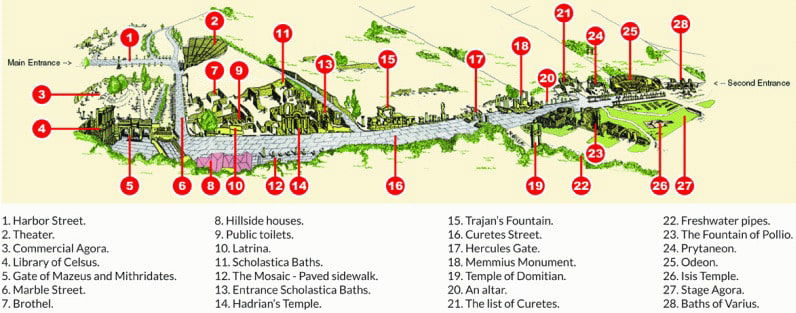
Brands We Use And Trust
Practical Ephesus Information (Hours, Fees, Entry Points)

First things first, do not be fooled into thinking this is a small site. You will need comfortable shoes, light clothing, sunscreen, a hat, and plenty of water. Ephesus is HUGE – you can spend all day here.
You could easily wander around the area all day and not get bored. When you turn one corner, you think you’ve seen it all, only to see another Roman road heading in another direction.
Ephesus Entrance Fee
The cost of visiting Ephesus Archaeological is 200 Lira. An audio guide or tour will cost extra. You can book guided tours online independently, or you can also arrange a guide at the entrance.
My Recommendation
I recommend you consider getting a Türkiye Museum Pass if you plan to visit Turkey and see more than two or three museums. The pass is valid for 15 days and covers several museums nationwide for just 1000 Lira. Or you could purchase the Aegean Museum Pass, which covers many attractions in the Aegean area, to not only save you a lot of money but it can also save valuable time.
Opening Hours Of Ephesus Archeological Site
Efes or Ephesos is also known as open daily. The last entry is 60 minutes before closing each day, but you need at least two hours, and that would be racing around each of the big sites.
In summer, you can enter Ephesus from 8 a.m. to 8 p.m. While in winter, the site stays open till 6:00 p.m. and opens at 8:30 a.m.
Address: Ephesus Ruins, 35920 Selçuk
E-mail: efesmuzesi@kultur.gov.tr
Tel: 02328926010
Which Entry To Use At Ephesus

Ephesus has two entrances: one at the northwest end near the Grand Theatre and the other at the southeast end near the Odeon.
The Southeast entrance near the Odeon is higher in elevation than the other entrance, so if you entered this way, it would be a downhill walk to see the sights.
It is possible to purchase tickets at both entrances, and they both have toilets to use before you start.
Most visitors and tours enter through the south entrance and leave through the north entrance as that is how tour companies plan things – so people walk downhill and get collected at the second entrance.
There is parking at both entrances for a small fee. We parked our rental car at the southwest entrance, walked uphill, saw the sights, and came back downhill slowly to see the magical Library of Celcius a second time. I totally recommend that if you drive yourself. There are also souvenir shops, a cafe, and seats at this entrance.
You can walk the 3 km from Selçuk to the lower entrance, which my guide told me can take 30 mins to an hour, depending on your fitness level.
Best Time To Visit Ephesus

When visiting Ephesus, it’s a good idea to try to avoid the peak summer months if possible. Ephesus is one of Türkiye’s most popular sites, and its close proximity to many beach resorts means that day trips are totally doable.
This means large crowds of summer day-trippers. And groups and heat do not make for the most enjoyable day!
May, June, late September, and October are ideal, and if you’re visiting during the winter months, head over on a sunny day to enjoy a far quieter experience in this stunning ancient city.
Top Insider Tips For Visiting The City Of Ephesus

With the list of things to do in Ephesus covered, you should know that this once-ancient Greek city of Ephesus is not a place you can visit in just a few hours. Here are our top tips to get the most out of this UNESCO-listed site in Turkey.
- Visit outside of the peak season months if you can. Fewer people make the experience better – we loved having most of the place to enjoy without anyone around. My guide told me 1000 of people are here daily in summer
- Wear comfortable shoes and avoid flip-flops. Flip-flops are a recipe for a slip and fall! A lot of Ephesus consists of marble pathways that go up and downhill, and they are slippery
- Wear a hat and sunscreen during the summer months. There isn’t a lot of shade in Ephesus, and the Turkish summer sun can be unforgiving. Even in February, we needed our sunglasses
- Take your time, make sure to sit down, and have a drink of water every so often. It’s surprising how many people try and motor their way around only to become tired and run out of steam to see the whole complex
- Budget appropriately. Ephesus isn’t the cheapest museum to visit, but it’s certainly worth it. You will need to pay extra if you want to see the House of Virgin Mary, so bear this in mind when budgeting
- Ensure you don’t miss the last train or bus back to your accommodation. If you did not arrive on tour or drive yourself, be sure to leave enough time to walk to your bus or train stop
- Stop for breakfast as you enter Selcuk. There are some fantastic roadside restaurants in town, many of which offer a stunning view of the mountainside and serve a delicious, traditional Turkish breakfast
- Clear out your camera memory card. You’re going to need the space!
- Arrive early to make the most of the whole day. In summer, the place is scorching; arriving early helps you beat the midday heat.
- Photograph the Celsus Library early in the morning to have the best lighting.
Book A Tour Of Ephesus
How To Get To Ephesus

Now that you know how to visit Ephesus, there are a few ways to get to Ephesus, and because it’s close to a major city, that makes logistics much easier!
From Istanbul
If you’re heading to Türkiye and landing in Istanbul, you can take a domestic flight to Izmir. From there, you can take the bus (Pamukkale and Kamil Koc are two bus services that run around Turkey and are high-quality options), or you can arrange a tour that will take you directly to Ephesus. The journey time is only around one hour either way. It only takes just over an hour and several daily flights from both of Istanbul’s airports.
From Selcuk
Alternatively, you can spend some time in Selcuk, which is around 45 minutes away from Izmir. To get to Ephesus from there, you can take the minibus, which runs several times daily and takes only 5 minutes. A taxi is another option.
From Kusadasi
Finally, if you’re staying in Kusadasi, you can take a taxi or head to Selcuk via the local bus network and then take the quick minibus from there.
Move This Adventure To Your Inbox & Get An Instant Freebie

No spam. Unsubscribe at any time.
Where To Stay Near Ephesus

Izmir is a large area, and choosing where to stay near Ephesus can be tricky because there are thousands of choices. The closest place to stay when visiting Ephesus is Selcuk; that said, if you want to explore the region of Izmir further, we might suggest one of these districts instead.
- Balçova
- Bayraklı
- Bornova
- Buca
- Çiğli
- Gaziemir
- Güzelbahçe
- Karşıyaka
- Konak
- Foça
- Selçuk
Ephesus Experience Museum – Efes Deneyim Müzesi

If you’re planning a trip to Ephesus and looking to dive deeper into its rich history, the Ephesus Experience Museum offers a unique and engaging way to do just that.
Think of it as a high-tech bridge to the past. This museum isn’t your typical walk-and-observe type; it’s an interactive journey that uses state-of-the-art visuals and sound to literally transport you back to ancient Ephesus. Imagine strolling through the streets of a city that thrived 8,000 years ago, experiencing the daily life of the Roman Empire, and marveling at wonders like the Temple of Artemis and the Celsus Library, all without the constraints of time.
The museum’s immersive approach makes you feel like a part of history, not just a bystander. It’s a fantastic addition to your Ephesus itinerary, especially if you’re keen on understanding the full story behind these ancient stones. Plus, it’s a great option if you’re traveling with kids or anyone who loves a bit of tech with their history.
Address: Acarlar, Efes Antik Kenti, Antik Tiyatro Karşısı, 35920 Selçuk/İzmir, Türkiye
Important Cities Close To Ephesus To Explore

When visiting Ephesus, you could easily add in a few other spots. While Ephesus is surrounded by countryside, it’s relatively close to Izmir, Kusadasi, Aydin, and Selcuk.
Selcuk Turkey
Selcuk is the closest place to Ephesus, at just one mile away. This large town is quite touristy, so you can easily find somewhere to stay and plenty of fantastic restaurants to try local food and excellent Turkish breakfasts. While in Selcuk, visit the Grand Fortress of Selcuk, which sits on top of a hill and has amazing views
Izmir Türkiye

The bustling coastal city of Izmir. Izmir is a fantastic, young, vibrant, and hip city with history lurking behind every corner. Located on the Aegean coastline, this bustling coastal city is also super-pretty, with a beautiful blend of old and new. The nightlife is vibrant and varied, the gastronomy is seriously on point, and there is plenty of history to explore simultaneously.
How far from Izmir to Ephesus: It is a little over 80 km (50 miles), which takes around an hour by car.
Kusadasi Türkiye
If you want to kick back and relax, get a tan, and enjoy the summer temperatures (although warned, they’re hot), you should head to this tourist resort on the south coast with plenty to see and do. Lapped by the Aegean and Mediterranean, Kusadasi is close to Izmir and ideal for a city and beach break.
Photos Of Efes, Turkiye To Inspire You To Visit
Ephesus FAQ
How much time is needed to visit?
You will need at least one day to see the top sites, but if you want a little more time to explore, especially in the museum and the Isa Bey Mosque, we’d recommend two days.
Is Ephesus a Wonder of the World or a UNESCO Site?
Ephesus is a UNESCO site and is also home to the Temple of Artemis, one of the original 7 Wonders of the World.
What should I wear in Ephesus?
It’s always sunny and hot at the sight, so lightweight clothing, sun hats, sunscreen, and sunglasses are all a must. Good walking shoes are also key when spending the day on your feet.
Can I tour Ephesus without a guide?
While guides offer great historical context and knowledge as you explore, it is entirely okay to tour the site on your own.
Is there an audio guide option?
At the gate, you can choose an audio guide for your self-tour, offered in 10 different languages, including English, Spanish, French, and German.
Where should I stay when visiting Ephesus?
Find a hotel or hostel in Izmir, Selcuk, or Kusadasi
When is the best time to visit Ephesus?
Visit during the shoulder months of the year – May, June, late September, and October are ideal.
- Best Hotels In Cappadocia Türkiye
- Best Places To Visit In Turkey For Every Type Of Traveler
- Incredible Black Sea Resorts
- Hotels In Cappadocia Türkiye
- Myths & Misbeliefs About Turkey
- What To Pack For Turkey
- 5 Reasons To Visit Gallipoli, Türkiye
- How To Get From Istanbul To Cappadocia
- Cappadocia Hot Air Ballon Ride Tips
- Greek Island Day Trip From Southern Turkey
- Discover Aydin City & Province
- Turkish Hammam Tips To Know Before You Go
- Tips For Traveling Turkey On A Budget
- Tips For Visiting Gobekli Tepe Archaeological Site
- Guide To The Ancient City Of Dara







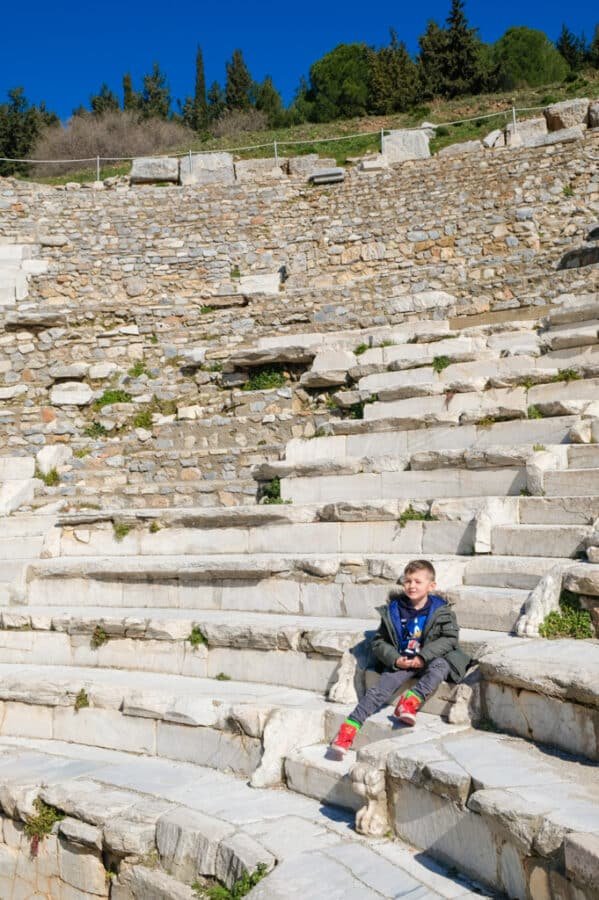












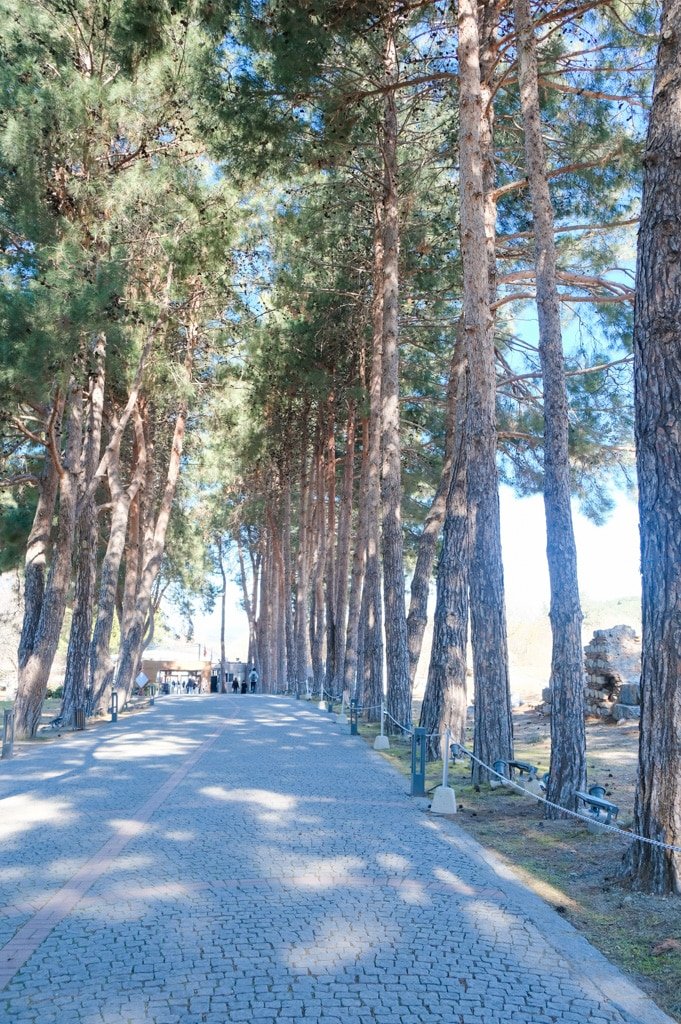
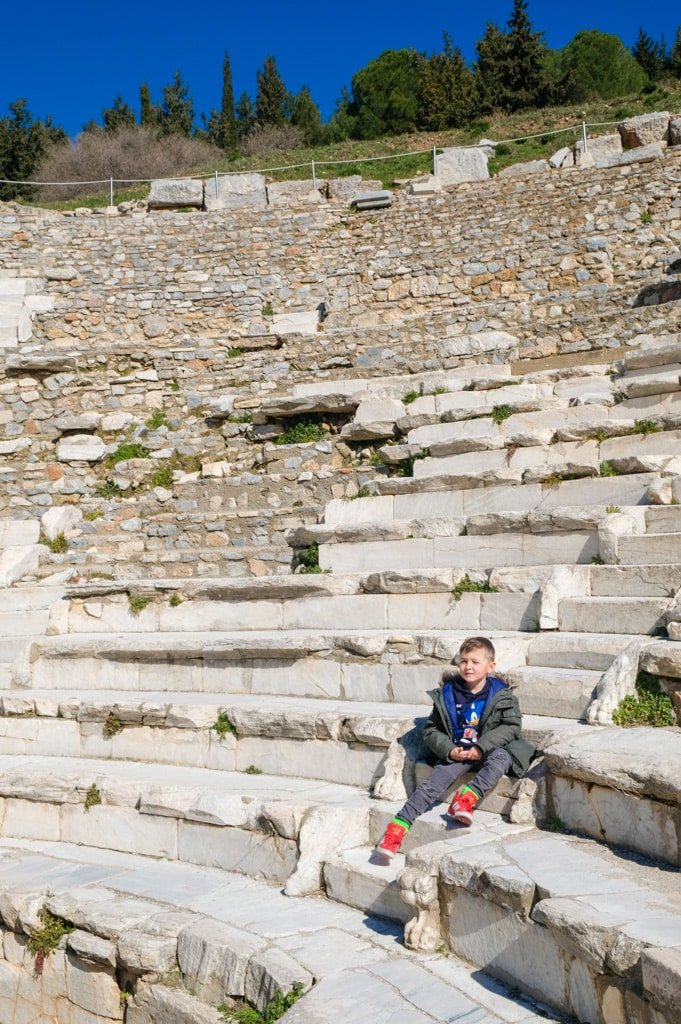
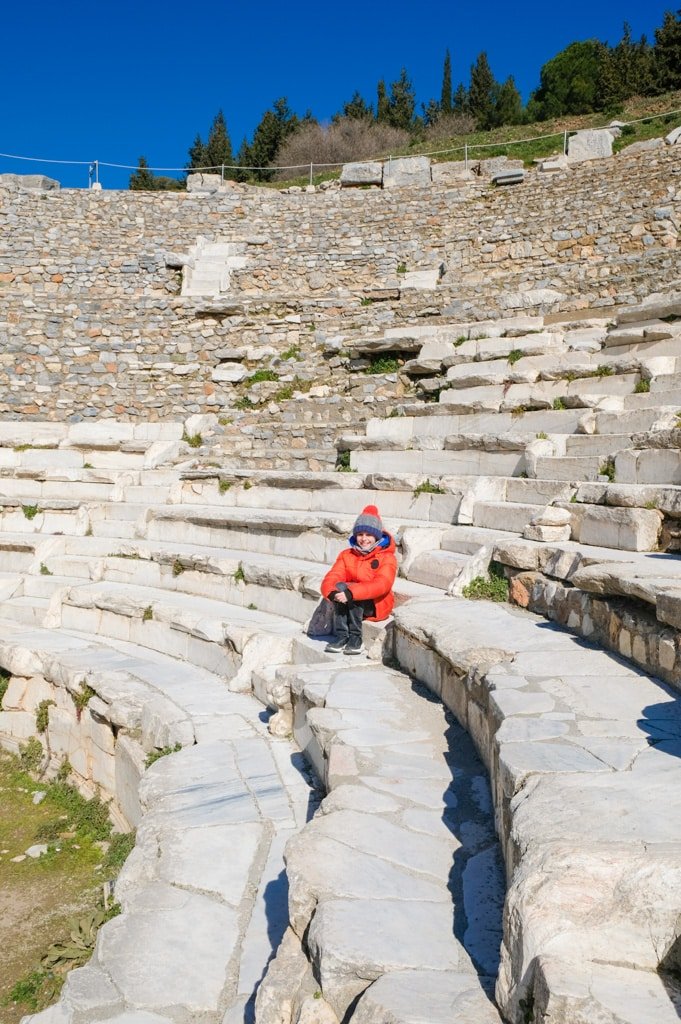


Ephesus is one of the most beautiful area in Izmir, even in Turkey.. You can visit our blog about destinations from Turkey if you want
Ephesus, Turkey
2024 Official Ephesus Archaeological Site Entrance Fees and Opening Hours
Ephesus — Ephesus Terrace Houses — Ephesus Museum —
Temple of Artemis — St. John Basilica — House of Virgin Mary.
Combo Ticket: Ephesus + Terrace Houses 52.00 €
Combo Ticket: Ephesus + Ephesus Terrace Houses + Ephesus Museum + Basilica of St. John — 65.00 €
Tickets are available at the entry gates.
Ephesus — 40.00 €
Terrace Houses — 15.00 €
Ephesus Museum — 10.00 €
Basilica of St. John — 6.00 €
House of Virgin Mary — 400.00 TL – ( ≈ 11.00 € )
Euro pricing is valid as of March 1, 2024
01.03.2024 exchange rate
Opening Hours:
Ephesus Ancient City—Basilica of St. John–Archaeological Museum of Ephesus
April — October
Opening Time: 8.00
Closing Time: 19.00
November — March
Opening Time: 8.00
Closing Time: 17.00
Ephesus Terrace Houses
April — October
Opening Time: 8.00
Closing Time: 18.30
November — March
Opening Time: 8.00
Closing Time: 16.30
House of Virgin Mary
April — October
Opening Time: 8.00
Closing Time: 17.00
November — March
Opening Time: 8.00
Closing Time: 17.00
Wow, thanks so much for that great updated info.